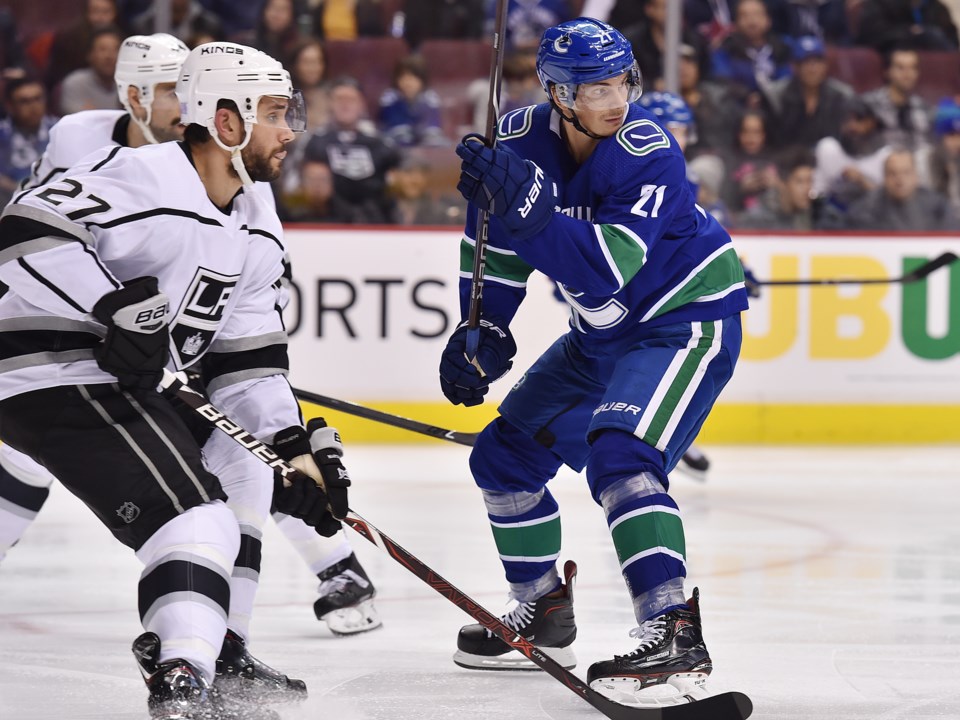The vast majority of Canucks fans are frustrated with Loui Eriksson. If you’re not, perhaps it’s because you’ve become inured to his overall mediocrity this season, which is understandable: he’s become less and less noticeable as the season has progressed.
If you’re frustrated with Eriksson, however, imagine how Jim Benning must feel.
Eriksson is Jim Benning’s biggest free agent signing, one that is indelibly connected to his tenure as General Manager of the Vancouver Canucks. Benning has signed other big names in free agency — Ryan Miller, Radim Vrbata, and Thomas Vanek, to name a few — but none to as big a contract as Eriksson: six years at $6 million per year.
Once the Sedins retired, Eriksson became the Canucks’ highest paid player, but it was already clear that he wasn’t going to live up to the expectations of his contract. He certainly didn’t live up to Benning’s expectations.
“When we signed him, we expected him to be a consistent 20-goal scorer,” said Benning on Monday. “He hasn’t done that. That part, that’s been disappointing.”
Perhaps it was too much to expect a forward on the wrong side of 30 to continue to score 20 goals per season, particularly through all six years of his lucrative contract. It wasn’t like Eriksson was particularly consistent in the years leading up to him signing with the Canucks.
In his contract year, Eriksson had 30 goals, but prior to that had 22 goals, and managed just 10 goals in 61 games in his first season with the Bruins. Benning should have been well aware of the possibility of Eriksson underperforming — he was there in Boston as Assistant General Manager when they traded for him in the Tyler Seguin deal. He watched Eriksson score those 10 goals firsthand.
Still, it’s understandable that he would have expected more goals out of Eriksson, at least in his first couple seasons. Eriksson had shown chemistry with the Sedin twins in international play with Sweden and the hope was he could rekindle that chemistry in Vancouver. It was a miscalculation, as what the slowing Sedins needed most was a speedy winger that could retrieve the puck, not a similarly slowing Swede.
Earlier this season, it looked for a moment like Eriksson could once again be a top-six forward, starting on a line with the Canucks’ underbarn Elias Pettersson.
On that line, Eriksson provided the little details that could help the fresh-faced rookie acclimatize to the NHL. He played a strong defensive game, provided deep support in the defensive zone on breakouts, won puck battles, and put himself in good positions in the offensive zone to support Pettersson’s game.
The issue, of course, is that Eriksson didn’t put up points with Pettersson, and head coach Travis Green moved on from that duo as the season progressed and shifted Eriksson into a far more defensive role. In recent weeks, Eriksson has skated on what is ostensibly the fourth line with Jay Beagle and Tyler Motte. Combining Eriksson’s $6 million cap hit with Beagle’s $3 million cap hit makes for what is likely the most expensive fourth line in the league.
“Travis uses that line as a matchup line and they play against the other team’s top two lines on any given night,” said Benning. “I think he’s been one of our better penalty killers and he’s filled a role for us.
“But that’s something that we’re going to sit down and talk to Loui and when we have our review with our coaches, we’ll talk to them at the end of the year, and make a decision as to where he fits in going forward.”
Eriksson has been relatively effective as a shutdown winger this season. Among Canucks forwards, he has the third-lowest rate of scoring chances against at 5-on-5, and the fourth-lowest rate of goals against.
In addition, his statistics on the penalty kill back up Benning’s assertion that he’s one of the Canucks’ best penalty killers. He leads Canucks penalty killers with the lowest rate of shot attempts against, unblocked shot attempts against, shots against, and scoring chances against, and is second to Brandon Sutter in goals against. In fact, his penalty kill advanced stats suggest he’s one of the best penalty killers in the entire NHL.
The issue is that Eriksson has become a black hole offensively. While he’s managed 10 goals and 22 points this season, the Canucks barely score when he’s on the ice at 5-on-5. Some of that comes by virtue of his role, but it’s tough to swallow a player making $6 million that only prevents opposition offence and doesn’t create any of his own.
Benning’s suggestion that they’re going to look to see where Eriksson “fits in going forward” is intriguing. Buying out Eriksson is unlikely, as his bonus-laden contract is essentially buyout proof. Trading him is also unlikely, as few teams will want to take on his cap hit, even if he was moved after the Canucks paid out one of his bonuses.
What other options do the Canucks have? Send him down to the AHL, where he would still be paid his full NHL contract and only save $1.025 million off the salary cap? That might not be worth the message that might send to other NHL free agents.
The Canucks might just need to resign themselves to using Eriksson as a defensive specialist for the three years remaining on his contract. They’re going to be paying him anyway, they might as well extract what value they can.



